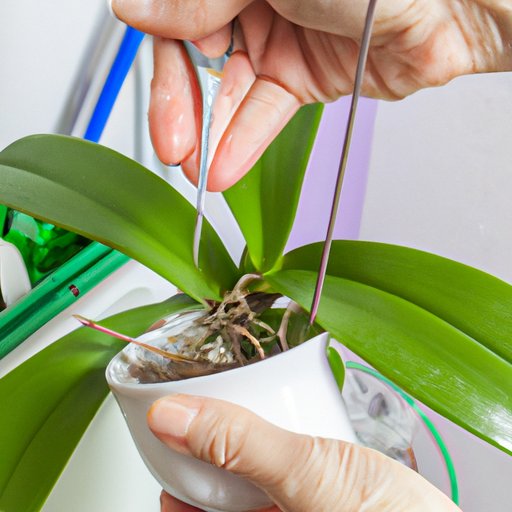Introduction
Orchids are some of the most beautiful and exotic plants in the world. From colorful petals to unique shapes, these flowers come in many varieties and can make a great addition to any home. However, caring for orchids at home can be a bit difficult if you don’t know what you’re doing. This article will provide an overview of how to properly care for orchids at home, including information about choosing the right type of orchid, providing adequate light and humidity, watering regularly and appropriately, repotting, fertilizing, pruning, and controlling pests and diseases.
Choosing the Right Type of Orchid
When it comes to choosing an orchid, there are many factors to consider. First and foremost, it is important to consider your home environment. Different types of orchids require different levels of light, humidity, and temperature, so it is important to find one that can thrive in your home. Additionally, different types of orchids have different bloom cycles, so it is important to choose one that will fit into your lifestyle.
There are many different types of orchids, but some of the most popular include Phalaenopsis, Cattleya, Paphiopedilum, Oncidium, and Dendrobium. Each type of orchid has its own unique characteristics, so it is important to do your research before making a purchase. It is also important to note that some orchids may require more attention and care than others, so it is important to choose one that is suitable for your level of expertise.

Providing Adequate Light and Humidity
In order for your orchid to thrive, it is important to provide adequate light and humidity. Understanding the light requirements of your orchid is key. Generally speaking, orchids prefer indirect light, such as from an east-facing window. They should not be placed in direct sunlight, as this can cause sunburns and damage the leaves. Additionally, it is important to understand the humidity requirements of your orchid. Most orchids prefer a humidity level between 40 and 70 percent, so it is important to monitor the humidity level in your home.

Watering Your Orchid Regularly and Appropriately
Orchids need to be watered regularly in order to stay healthy. The amount of water needed will vary depending on the type of orchid, but generally speaking, it is best to water your orchid once every 7 to 14 days. When watering your orchid, it is important to use lukewarm water and avoid soaking the entire plant. Additionally, it is important to avoid over-watering your orchid, as this can lead to root rot.
Repotting Your Orchid
Repotting your orchid is an important part of orchid care. Repotting helps to ensure that your orchid has enough room to grow and that the soil remains fresh. Generally speaking, it is best to repot your orchid every two to three years. When repotting, it is important to use a potting mix specifically designed for orchids, as regular potting soil can be too heavy and retain too much moisture. Additionally, it is important to make sure that the new pot has drainage holes to prevent root rot.
Fertilizing Your Orchid
Fertilizing your orchid can help to ensure that it receives all the nutrients it needs to stay healthy. There are many different types of orchid fertilizers available, including liquid, granular, and slow-release formulations. It is important to read the instructions carefully and follow the recommended dosage and frequency. Additionally, it is important to only fertilize your orchid when it is actively growing.
Pruning Your Orchid
Pruning your orchid is an important part of orchid care. Pruning helps to encourage new growth, remove dead or dying blooms, and keep the plant looking neat and tidy. It is important to use sharp, clean pruning shears and cut just above a node (where the stem meets the leaf). Additionally, it is important to remove any damaged or diseased parts of the plant promptly to prevent the spread of disease.
Controlling Pests and Diseases
Unfortunately, pests and diseases can be a problem with orchids. Common pests include aphids, mealybugs, scale insects, and spider mites. Common diseases include bacterial blight, fungal diseases, and root rot. The best way to prevent pests and diseases is to practice proper orchid care, including providing adequate light and humidity, watering regularly and appropriately, repotting, fertilizing, and pruning.
Conclusion
Caring for orchids at home can be a rewarding experience. With the right knowledge and tools, you can ensure that your orchid stays healthy and blooms beautifully. When selecting an orchid, it is important to consider your home environment and choose one that is suitable for your level of expertise. Additionally, it is important to provide adequate light and humidity, water regularly and appropriately, repot, fertilize, prune, and control pests and diseases.
By following these tips, you can ensure that your orchid stays healthy and blooms for many years to come.
(Note: Is this article not meeting your expectations? Do you have knowledge or insights to share? Unlock new opportunities and expand your reach by joining our authors team. Click Registration to join us and share your expertise with our readers.)
